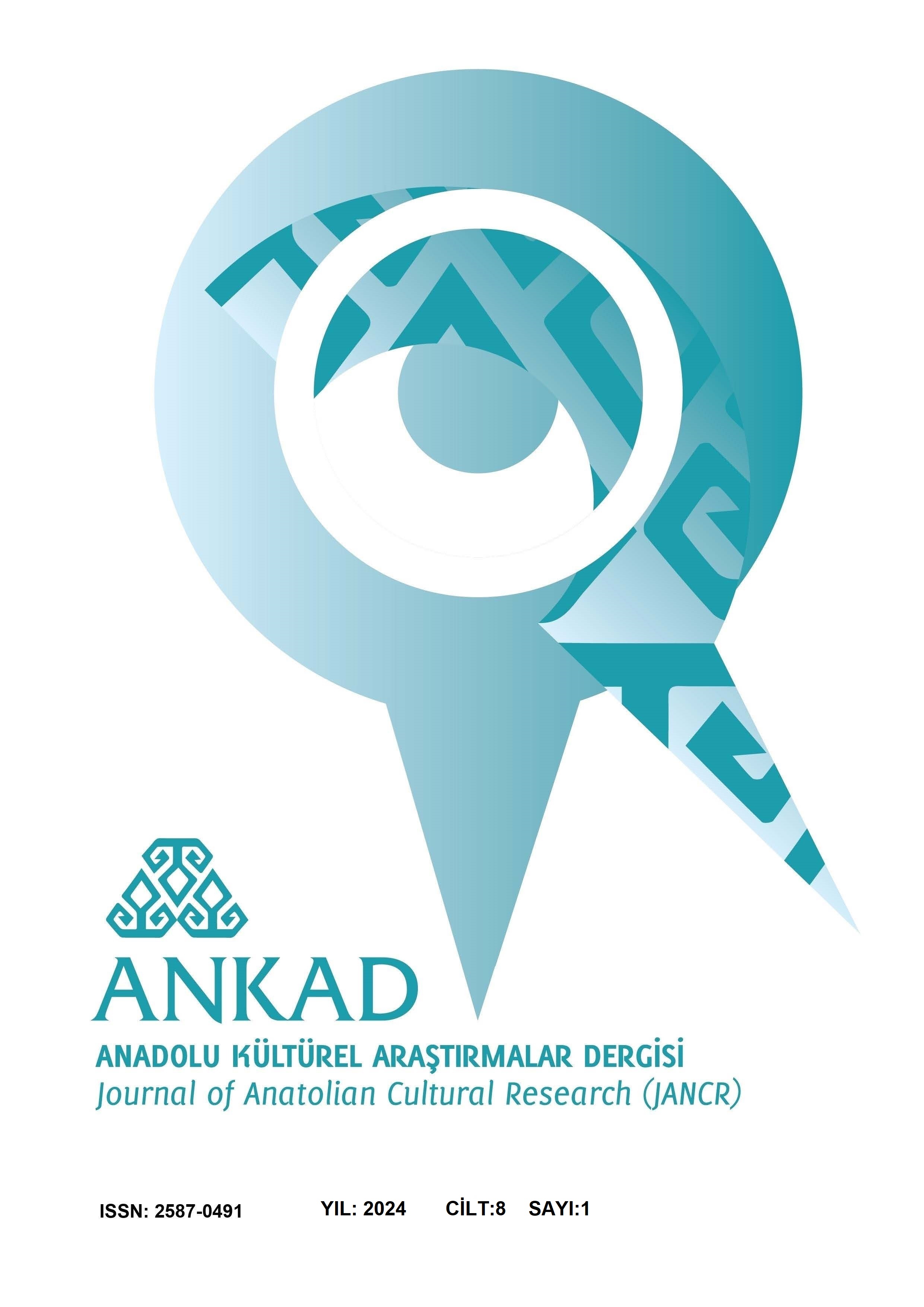Bursa Uluslararası İpek İğne Oya Festivali ve Tasarım Yarışması
DOI:
https://doi.org/10.15659/jancr.v8i1.171Anahtar Kelimeler:
Kültür- merinos tekstil sanayi müzesi- Bursa- ipek- oyaÖzet
Oya, Anadolu el sanatlarının önemli ve bilinen parçalarından biridir. Anadolu kadını tarih boyunca el emeği, göz nuru olarak işlediği oyaları, genç kızların çeyiz sandıklarında bulundurmuş, oya üretimi yaparak ve satarak ev ekonomisine katkı sağlamıştır. Günümüzde modern tekstil sanayi ve dijital dünya arasında sadece geleneğin bir parçası olarak özel günlerde hatırlanan oyalar, Anadolu kültüründe kaybolmaya yüz tutmuş üretimler arasında yerini almıştır. Buna karşın yurt dışından gelip bu üretim tekniğini öğrenerek kendi kültürlerinde sürdürülebilir kılmak istedikleri için çeşitli projeler yürüten kişiler de bulunmaktadır. Anadolu’da oya üretiminin sürdürülebilir olarak gelecek kuşaklara tanıtımı ve aktarımı için yapılan örnek etkinliklerin bulunması, yaşayan miras kavramı açısından umut verici niteliktedir. Bursa Uluslararası İpek İğne Oya Festivali ve Tasarım Yarışması bu çalışmanın kapsamını oluşturmaktadır. Çalışmanın amacı, anılan etkinliğin oya üretiminin korunması ve yaşatılması için diğer merkezlere örnek oluşturmasına ve bu tür etkinliklerin sayısının artmasına katkı sağlamasının önemine dikkat çekmektir. Çalışmada literatür taraması yapılmış, festival ve yarışma düzenleme komitesindeki yetkililer ile görüşülmüş, kişisel arşivlerde ve Bursa Merinos Tekstil Sanayi Müzesi Arşivi’nde yer alan fotoğraflar ile metin kısmı desteklenmiştir. Çalışmanın ilk bölümünde oya üretiminin Anadolu kültüründeki önemine yer verilmiş, ikinci bölümde ise adı geçen festival ve yarışmanın ortaya çıkışı ele alınarak konuya olan katkısı aktarılmıştır.
Günümüzde modern tekstil sanayi ve dijital dünya arasında sadece geleneğin bir parçası olarak özel günlerde hatırlanan oyalar, Anadolu kültüründe kaybolmaya yüz tutmuş üretimler arasında yerini almıştır. Buna karşın yurt dışından gelip bu üretim tekniğini öğrenerek kendi kültürlerinde sürdürülebilir kılmak istedikleri için çeşitli projeler yürüten kişiler de bulunmaktadır. Anadolu’da oya üretiminin sürdürülebilir olarak gelecek kuşaklara tanıtımı ve aktarımı için yapılan örnek etkinliklerin bulunması yaşayan miras kavramı açısından umut verici niteliktedir. Bursa Uluslararası İpek İğne Oya Festivali ve Tasarım Yarışması bu çalışmanın kapsamını oluşturmaktadır. Çalışmanın amacı, anılan etkinliğin oya üretiminin korunması ve yaşatılması adına diğer merkezlere örnek oluşturmasına ve bu tür etkinliklerin sayısının artmasına katkı sağlamak için önemine vurgu yapmaktır. Çalışmada literatür taraması yapılmış, festival ve yarışma düzenleme komitesindeki yetkililer ile görüşülmüş, kişisel arşivlerdeki ve Bursa Merinos Tekstil Sanayi Müzesi Arşivinde yer alan fotoğraflar ile de metin kısmı desteklenmiştir. Çalışmanın ilk bölümünde oya üretiminin Anadolu kültüründeki önemine yer verilmiş, ikinci bölümde ise adı geçen festival ve yarışmanın ortaya çıkışı ele alınarak konuya olan katkısı aktarılmıştır.
Anahtar Kelimeler: Kültür, Merinos Tekstil Sanayi Müzesi, Bursa, İpek, Oya.
Referanslar
Aksoy E. ve Öz N. D. (2018). 19.-20. Yüzyılda Harput’ta ipek böcekçiliği ve dokumacılık. 9. Milletlerarası Türk Halk Kültürü Kongresi 20-23 Kasım 2017 içinde (s. 15-32). Cilt: 5, Ankara: T.C. Kültür ve Turizm Bakanlığı Yayınları.
Alkan, F.ve Koyuncu Okca, A. (2023). Müze-toplum ilişkisinin geliştirilmesinde müze etkinliklerinin önemi: Bursa Büyükşehir Belediyesi müzeleri. Beyşehir Selçuklu 1. Uluslararası Sosyal ve Beşeri Bilimler Kongresi 27-29 Ekim 2023 içinde (s. 1293-1307). Konya: Akademik Global Yayınları.
Anonim (1997). “Oya”. Eczacıbaşı Sanat Ansiklopedisi, c. 3, , İstanbul :Yem Yayınları, s.1440.
https://nisanyansozluk.com, Erişim Tarihi: 27.02.2023
https://ci.turkpatent.gov.tr/cografi-isaretler/detay/3004 Erişim Tarihi: 27.02.2023
https://sozluk.gov.tr, Erişim Tarihi: 27.02.2023
Elbas, A. (2015). Merinos, Bursa: Bursa Büyükşehir Belediyesi Yayınları.
Gümüş, D. ve Uray G. (2018). Oya el sanatı üzerine bir inceleme. Uluslararası Sosyal Araştırmalar Dergisi, Cilt: 11, (55), 355-369.
Karabaşa, S. ve Kara, Ç. (2022). Oyanın mirası Nallıhan İğne Oyasının miras olma serüveni. Folklor/Edebiyat, Yıl: 28, (110), 499-522.
Karademir, A. (2015). İğne iplikle açan çiçekler. Prusa Dergisi, 23-29.
Karhan, N. (2018). Geçmişten günümüze. Bursa İpek İğne Oyaları Uluslararası İpek Oya Festivali Broşürü. Bursa Büyükşehir Belediyesi.
Koyuncu, A. (2007). Bucak İlçesinde oya-insan ilişkileri. I. Burdur Sempozyumu Bildiriler 16-19 Kasım 2005 içinde (s. 39-49) Cilt: 1. Burdur: Mehmet Akif Ersoy Üniversitesi Yayınları.
Koyuncu Okca, A. ve Öz, N. D. (2019). Kaybolmaya yüz tutmuş kültürel miras: Karapınar tülü dokumaları. Sanat ve Tasarım Dergisi, (24), 281-299.
Koyuncu Okca, A. vd. (2020). Kaybolmaya yüz tutmuş kültürel miras: yorgancılık mesleğinin değişim ve dönüşümü. Akademik Tarih ve Düşünce Dergisi, Sayı: 7, 1758-1781.
Markaloğlu, Ş. (1984). Geleneksellik ve gelir açısından Nallıhan iğne oyaları. Türk Folkloru Araştırmaları 1983, Ankara: G.Ü. Basım Yayın Yüksek Okulu Basımevi.
Nonaka, I. (2018). Türk iğne oyası ve Japonların el sanatı olarak Türk iğne oyasına bakış açıları ve yaklaşımları. Bursa İpek İğne Oyaları Uluslararası İpek Oya Festivali Broşürü. Bursa Büyükşehir Belediyesi.
Onuk, T. (2000). Osmanlıdan Günümüze Oyalar, Ankara: Kültür Bakanlığı Yayınları.
Öz, D. (2016). Kişisel koleksiyonlarda bulunan bitkisel motifli yazma başörtüleri. V. International Turkic Art, History And Folklore Congress/Art Activities, 13-16 Nisan içinde (s.121-126) Cilt:1, Moldova: Komrat Devlet Üniversitesi.
Öz, N. D. vd. (2018). Block printing: one of lost treasures of Mardin, Asia Minor Studies, 6 (AGP Sempozyum Özel Sayısı), 166-175.
Öz, N. D. (2022). Geleneksel yazmacılık ve hürriyet yazmalar, Akademik Tarih ve Düşünce Dergisi, C. 9, (4), 1534-1551.
Özcan, F. (1997). Nallıhan yöresinde iğne oyacılığı. Ankara: Kültür Bakanlığı Yayınları.
Palliser, B. (1902). History of lace, (Ed. M. Jourdain ve Alice Dryden). New York: Dover Publications.
Sürür, A. (2018). Türk iğne oyası oluşturan değerler üzerine bir araştırma. Bursa İpek İğne Oyaları Uluslararası İpek Oya Festivali Broşürü. Bursa Büyükşehir Belediyesi.
Tansuğ, S. (1988). Türklerde çiçek sevgisi ve “Sümbülname”. İstanbul: Ak Yayınları Türk Süsleme Sanatları Serisi 14-4, Grafik Sanatlar Matbaacılık A.Ş.
Kaynak Kişiler
KK-1: Ayşegül Kömürcüoğlu: 1982, Bursa, Merinos Tekstil Sanayi Müzesi’nde görevli, Uluslararası İpek İğne Oyası Festivali ve Tasarım Yarışması organizasyon sorumlusu, Görüşme Tarihi: 25.02.2023, Bursa.
KK-2: Emine Semra Erkan: 1942, İstanbul, oya araştırmacısı ve koleksiyoneri, Görüşme Tarihi: 12.02.2024, İstanbul.
KK-3: İbrahim Koca: 1968, Bursa, oya koleksiyoneri ve antikacı, Görüşme Tarihi: 23.02.2023, Bursa.
KK-4: Serap Tuba Yurteser Yılmaz, 1980, Bursa Müze Sergiler Koordinatörü ve Çiçeklerin Düğünü İpek İğne Oyası Sergisi Küratörü, Görüşme Tarihi: 19.02.2024, Bursa
İndir
Yayınlanmış
Nasıl Atıf Yapılır
Sayı
Bölüm
Lisans
Telif Hakkı (c) 2024 Anadolu Kültürel Araştırmalar Dergisi (ANKAD)

Bu çalışma Creative Commons Attribution-NonCommercial 4.0 International License ile lisanslanmıştır.













